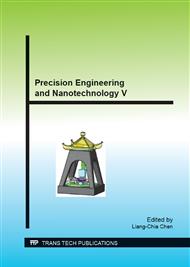p.288
p.297
p.305
p.310
p.316
p.322
p.326
p.332
p.339
Identification of Fluids by the Color of Surface Plasmon Polaritons
Abstract:
When optical waves make the free electrons on a metal surface resonate, optical energy propagates along the surface as density waves of the free electrons. The longitudinal waves and electrical fields of the electrons are called surface plasmon polaritons (SPPs), which are widely applied in high sensitivity sensors because the excitation of SPPs sensitively depends on the refractive index of the surrounding dielectric sample. Here, we report the identification of fluids by using the color dispersion of SPPs. Silver film on a prism surface is illuminated with white light to excite SPPs. A color component in the white light is thereby selectively coupled with SPPs due to the color dispersion that depends on the refractive index of the fluid on the film. Thus, theoretically, when the refractive index is changed, the color of SPPs changes as well. Our application uses a medium consisting of fluid samples to be identified. The proposed identification method can be applied to fluid analysis for label-free visualization of or as a simple analysis method, since the refractive indices or concentrations of the sample fluids directly affect the color of the SPPs, and this color can be visually identified. We theoretically confirmed that the color of SPPs excited with white light illumination can help to differentiate between water and ethanol. Experimentally, SPPs belonging to the frequency region of the color green were detected when the sample was water, and the color changed to red when ethanol was used instead. In the future, we plan to develop simple, small, sensitive, and low-cost sensors that can determine the concentration and refractive index of fluids on the basis of the color of the SPPs.
Info:
Periodical:
Pages:
316-321
Citation:
Online since:
August 2014
Authors:
Keywords:
Price:
Сopyright:
© 2015 Trans Tech Publications Ltd. All Rights Reserved
Share:
Citation:


